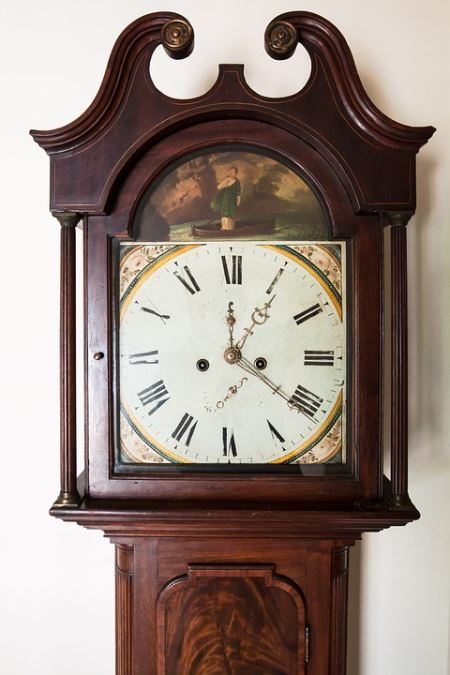Grandfather clocks are among the most difficult items to move due to their delicate nature and high value. While we typically recommend professional movers to handle heavy, high-value items, a DIY move approach is not difficult if you follow our steps.
Here are some basic steps to safely disassemble, pack, and reassemble your grandfather clock or floor clock to ensure that it will work effectively in your new home.

Grandfather Clock Packing List
Before you get started, make sure you have the correct materials and another person to help you transport a grandfather clock.
Here's what you’ll need:
- A clean microfiber cloth or soft gloves to remove parts
- Clean padding and furniture blankets
- Bubble wrap
- Moving dolly (available to rent at most truck rental stores)
- Medium moving box
- Used cardboard boxes for internal and external padding
- Large crate or custom box
- A van or moving truck for short moves
Once you have everything together, then it’s time to take your clock apart.
Disassembling and Packing a Grandfather Clock
It’s important to remember to never move a grandfather clock without first taking it apart. When fully assembled, the intricate pendulum and weight systems can bend, break, or swing into the fragile clock case. While it is best to hire a professional moving company to handle and move your clock for peace of mind, a DIY grandfather clock move can be done safely. If you decide to disassemble and pack it yourself, follow the below steps:
- Is the clock anchored to the wall? If it is, unscrew the brackets to detach the clock.
- Remove glass panels and the pendulum.
- Wear soft gloves or use a cloth to protect the brass pendulum from the oils on your skin
- Open the glass casing that contains the pendulum and weights.
- Stop the pendulum and remove it from the clock.
- While holding the pendulum in the middle, carefully lift it off the suspension spring that holds it in place.
- The pendulum should unhook easily.
- If the pendulum doesn’t move, don't force it.
- Remove internal clock weights and pendulums. Take the weights down in order.
- Be sure to mark the protective wrapping Left, Center, Right for easier re-installation.
- Use soft, protective padding or foam to wrap the weights.
- Place the weights in a box with crumpled paper.
- Take one or two sheets of newspaper and loosely wrap it around the pendulum guide inside the clock to keep it stationary.
- Tie chains or cables inside the clock to prevent tangling.
- If your clock has chains, secure them by bunching them top to bottom and then wrap them in old newspaper.
- Carefully tie the chains with a band to prevent tangling.
- Slide a sheet of cardboard behind the chains and carefully tape them to it.
- Wrap all loose items in bubble wrap; then wrap items in paper.
- Set the items inside a box with packing peanuts and crumpled paper.
Remove and Pack Loose Items
Make sure that the movement and any mobile elements are secured inside the clock case. If the movement can’t be secured, remove it and pack it separately with protective padding.
If you can remove the top of the clock or clock face, remove them. Wrap both items in bubble wrap and securely set it inside a moving box like you do with other loose items.
How to Protect a Grandfather Clock
When every loose piece is wrapped and boxed up, you can begin wrapping the clock. There is no single best way to protect your clock as long as you protect corners, edges, and glass pieces.
Here’s what we recommend:
- Drape a moving blanket over the top of the clock.
- Wrap another blanket around the sides.
- Secure the blankets with packing tape.
- Wrap bubble wrap around the blankets and secure with tape.
- To protect corners and edges – especially along the top and bottom of the clock:
- Wrap the clock in several cut open cardboard boxes and secure with tape.
- Make sure that you have completely covered the top and bottom edges.
If you don’t feel comfortable wrapping up your clock, you can order a packing crate and surround the clock with foam and plastic packing materials.
How to Move a Grandfather Clock onto a Truck
The clock can be moved when every loose piece is wrapped, labeled, and boxed – and the clock is padded and supported.
- With another person, slide the hand dolly under the clock, tip it backward, and pull the dolly up the loading ramp.
- Place the clock upright along the side or front of the truck and secure it in place with a strap.
How to Reassemble a Grandfather Clock
- When you arrive at your new home, find a place for your clock with level, stable flooring (carpets can make it difficult to find level spots)
- Be sure that the clock does not rock. Place small shims to stabilize the base on uneven flooring. Use a level on top of the clock to ensure that it’s level.
- Replace the movement if it was taken out.
- Attach the pendulum and the weights in the same order that you removed them.
- Remove the newspaper and tape from the chains, cables, and chime rods.
To restart your clock, move the pendulum from one side to another. If the "tick-tock" doesn’t sound right, you can shift the top to level it, or use shims or furniture pads under the feet.
Is a DIY Move too Much Work? Hire a Moving Company
If you’d rather not pack and move your grandfather clock, we have a range of excellent moving companies to choose from. Check out our network of reliable movers in your area – from small moves to international shipping, we’ll help you find the best solution for your moving needs.